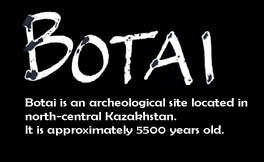



 |
||
 |
Welcome to the Botai Virtual Museum What makes up a Botai village? How are the houses constructed? A botai village is made up of houses that are rectangular or square and 5 and 8 meters on a side. The houses have adobe or clay walls. They may be whitewashed.The roof is lightweight and made up of small branches of wood. The wood may be covered with clay or horse dung. The houses do not have any center support beams. The houses are dug into the ground about 1 meter. Botai people are not very tall, so the walls may only be 1 meter high. The whole height around the edges may only be about 2 meters, with the center being higher. We can imagine that the roof is peaked, because of the snow. The houses are small (one room) with a simple peaked roof and white walls. There are no windows, but there is a little door facing west. A hole is made in the roof in the center to let smoke out. The hole has a flap over it to keep the rain and snow from coming in. The flap is made of horse hide. The houses have corners facing directions-east, west, north, and south. The houses are spread out sometimes in long rows that run from the northwest down to the southeast. Some houses are arranged around open plazas. The Botai settlement has at least 153 pithouses. The Carnegie Museum has been involved in excavating one pithouse and its surrounds. Experience the wonders of this ancient civilization! Come take a virtual tour of a botai village. We recommend you download QuicktimeVR [linked to quicktime VR plug-in]to help you along your journey. Artifacts
|
|